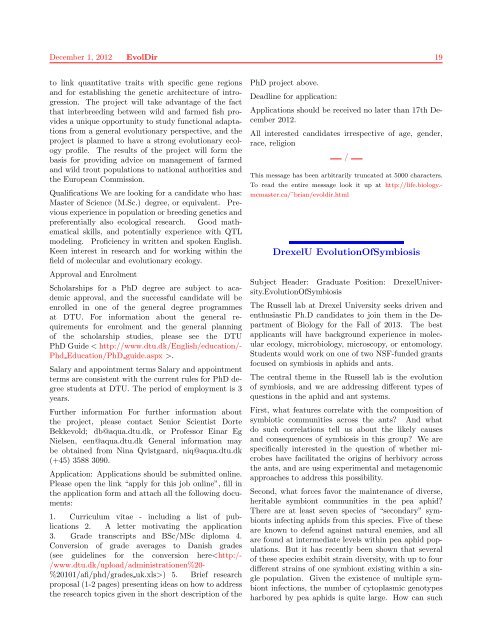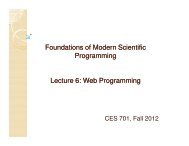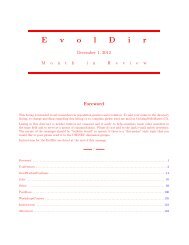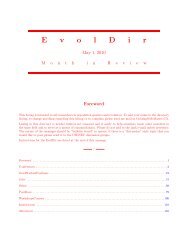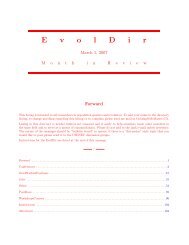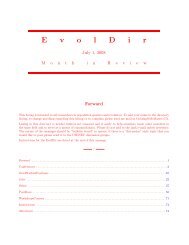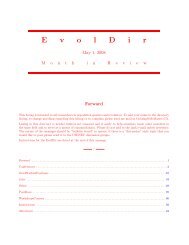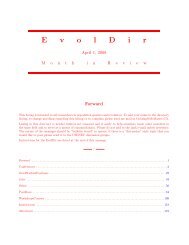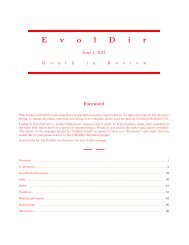E v o l D i r
E v o l D i r
E v o l D i r
You also want an ePaper? Increase the reach of your titles
YUMPU automatically turns print PDFs into web optimized ePapers that Google loves.
December 1, 2012 EvolDir 19<br />
to link quantitative traits with specific gene regions<br />
and for establishing the genetic architecture of introgression.<br />
The project will take advantage of the fact<br />
that interbreeding between wild and farmed fish provides<br />
a unique opportunity to study functional adaptations<br />
from a general evolutionary perspective, and the<br />
project is planned to have a strong evolutionary ecology<br />
profile. The results of the project will form the<br />
basis for providing advice on management of farmed<br />
and wild trout populations to national authorities and<br />
the European Commission.<br />
Qualifications We are looking for a candidate who has:<br />
Master of Science (M.Sc.) degree, or equivalent. Previous<br />
experience in population or breeding genetics and<br />
preferentially also ecological research. Good mathematical<br />
skills, and potentially experience with QTL<br />
modeling. Proficiency in written and spoken English.<br />
Keen interest in research and for working within the<br />
field of molecular and evolutionary ecology.<br />
Approval and Enrolment<br />
Scholarships for a PhD degree are subject to academic<br />
approval, and the successful candidate will be<br />
enrolled in one of the general degree programmes<br />
at DTU. For information about the general requirements<br />
for enrolment and the general planning<br />
of the scholarship studies, please see the DTU<br />
PhD Guide < http://www.dtu.dk/English/education/-<br />
Phd Education/PhD guide.aspx >.<br />
Salary and appointment terms Salary and appointment<br />
terms are consistent with the current rules for PhD degree<br />
students at DTU. The period of employment is 3<br />
years.<br />
Further information For further information about<br />
the project, please contact Senior Scientist Dorte<br />
Bekkevold; db@aqua.dtu.dk, or Professor Einar Eg<br />
Nielsen, een@aqua.dtu.dk General information may<br />
be obtained from Nina Qvistgaard, niq@aqua.dtu.dk<br />
(+45) 3588 3090.<br />
Application: Applications should be submitted online.<br />
Please open the link “apply for this job online”, fill in<br />
the application form and attach all the following documents:<br />
1. Curriculum vitae - including a list of publications<br />
2. A letter motivating the application<br />
3. Grade transcripts and BSc/MSc diploma 4.<br />
Conversion of grade averages to Danish grades<br />
(see guidelines for the conversion here) 5. Brief research<br />
proposal (1-2 pages) presenting ideas on how to address<br />
the research topics given in the short description of the<br />
PhD project above.<br />
Deadline for application:<br />
Applications should be received no later than 17th December<br />
2012.<br />
All interested candidates irrespective of age, gender,<br />
race, religion<br />
/<br />
This message has been arbitrarily truncated at 5000 characters.<br />
To read the entire message look it up at http://life.biology.-<br />
mcmaster.ca/˜brian/evoldir.html<br />
DrexelU EvolutionOfSymbiosis<br />
Subject Header: Graduate Position: DrexelUniversity.EvolutionOfSymbiosis<br />
The Russell lab at Drexel University seeks driven and<br />
enthusiastic Ph.D candidates to join them in the Department<br />
of Biology for the Fall of 2013. The best<br />
applicants will have background experience in molecular<br />
ecology, microbiology, microscopy, or entomology.<br />
Students would work on one of two NSF-funded grants<br />
focused on symbiosis in aphids and ants.<br />
The central theme in the Russell lab is the evolution<br />
of symbiosis, and we are addressing different types of<br />
questions in the aphid and ant systems.<br />
First, what features correlate with the composition of<br />
symbiotic communities across the ants? And what<br />
do such correlations tell us about the likely causes<br />
and consequences of symbiosis in this group? We are<br />
specifically interested in the question of whether microbes<br />
have facilitated the origins of herbivory across<br />
the ants, and are using experimental and metagenomic<br />
approaches to address this possibility.<br />
Second, what forces favor the maintenance of diverse,<br />
heritable symbiont communities in the pea aphid?<br />
There are at least seven species of “secondary” symbionts<br />
infecting aphids from this species. Five of these<br />
are known to defend against natural enemies, and all<br />
are found at intermediate levels within pea aphid populations.<br />
But it has recently been shown that several<br />
of these species exhibit strain diversity, with up to four<br />
different strains of one symbiont existing within a single<br />
population. Given the existence of multiple symbiont<br />
infections, the number of cytoplasmic genotypes<br />
harbored by pea aphids is quite large. How can such


